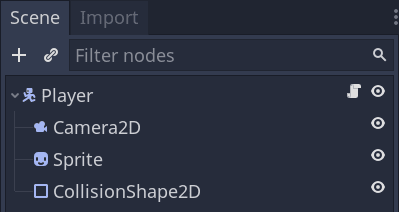Instâncias de nós e cenas¶
This guide explains how to get nodes, create nodes, add them as a child, and instantiate scenes from code.
Obtendo nós¶
You can get a reference to a node by calling the Node.get_node() method. For this to work, the child node must be
present in the scene tree. Getting it in the parent node's _ready() function
guarantees that.
If, for example, you have a scene tree like this, and you want to get a reference to the Sprite and Camera2D nodes to access them in your script.

Para isso, você pode usar o seguinte código.
var sprite
var camera2d
func _ready():
sprite = get_node("Sprite")
camera2d = get_node("Camera2D")
private Sprite _sprite;
private Camera2D _camera2d;
public override void _Ready()
{
base._Ready();
_sprite = GetNode<Sprite>("Sprite");
_camera2d = GetNode<Camera2D>("Camera2D");
}
Note that you get nodes using their name, not their type. Above, "Sprite" and "Camera2D" are the nodes' names in the scene.
If you rename the Sprite node as Skin in the Scene dock, you have to change the
line that gets the node to get_node("Skin") in the script.
Caminhos dos nós¶
When getting a reference to a node, you're not limited to getting a direct child. The get_node() function
supports paths, a bit like when working with a file browser. Add a slash to
separate nodes.
Take the following example scene, with the script attached to the UserInterface node.

Para obter o nó Tween, você usaria o código a seguir.
var tween
func _ready():
tween = get_node("ShieldBar/Tween")
private Tween _tween;
public override void _Ready()
{
base._Ready();
_tween = GetNode<Tween>("ShieldBar/Tween");
}
Nota
As with file paths, you can use ".." to get a parent node. The best practice is to avoid doing that though not to break encapsulation. You can also start the path with a forward slash to make it absolute, in which case your topmost node would be "/root", the application's predefined root viewport.
Syntactic sugar¶
You can use two shorthands to shorten your code in GDScript. Firstly, putting the
onready keyword before a member variable makes it initialize right before
the _ready() callback.
onready var sprite = get_node("Sprite")
There is also a short notation for get_node(): the dollar sign, "$". You
place it before the name or path of the node you want to get.
onready var sprite = $Sprite
onready var tween = $ShieldBar/Tween
Criando nós¶
Para criar um nó a partir do código, chame seu método new() como para qualquer outro tipo de dados baseado em classe.
You can store the newly created node's reference in a variable and call
add_child() to add it as a child of the node to which you attached the
script.
var sprite
func _ready():
var sprite = Sprite.new() # Create a new Sprite.
add_child(sprite) # Add it as a child of this node.
private Sprite _sprite;
public override void _Ready()
{
base._Ready();
_sprite = new Sprite(); // Create a new Sprite.
AddChild(_sprite); // Add it as a child of this node.
}
To delete a node and free it from memory, you can call its queue_free()
method. Doing so queues the node for deletion at the end of the current frame
after it has finished processing. At that point, the engine removes the node from
the scene and frees the object in memory.
sprite.queue_free()
_sprite.QueueFree();
Before calling sprite.queue_free(), the remote scene tree looks like this.
After the engine freed the node, the remote scene tree doesn't display the sprite anymore.
You can alternatively call free() to immediately destroy the node. You
should do this with care as any reference to it will instantly become null.
We recommend using queue_free() unless you know what you're doing.
When you free a node, it also frees all its children. Thanks to this, to delete an entire branch of the scene tree, you only have to free the topmost parent node.
Criando instâncias de cenas¶
Scenes are templates from which you can create as many reproductions as you'd like. This operation is called instancing, and doing it from code happens in two steps:
Carregando a cena salva no disco rígido.
Criando uma instância do recurso carregado PackedScene.
var scene = load("res://MyScene.tscn")
var scene = GD.Load<PackedScene>("res://MyScene.tscn");
Preloading the scene can improve the user's experience as the load operation happens when the compiler reads the script and not at runtime. This feature is only available with GDScript.
var scene = preload("res://MyScene.tscn")
Nesse ponto, scene é um recurso de cena compactado, não um nó. Para criar o nó atual, você precisa chamar PackedScene.instance(). Ele retorna uma árvore de nós que você pode ter como filho do seu nó atual.
var instance = scene.instance()
add_child(instance)
var instance = scene.Instance();
AddChild(instance);
A vantagem deste processo de duas etapas é que você pode manter uma cena compactada carregada e criar novas instâncias em tempo real. Por exemplo, para rapidamente instanciar vários inimigos ou balas.